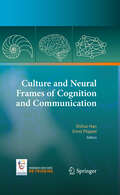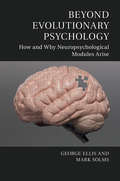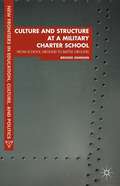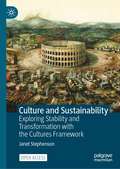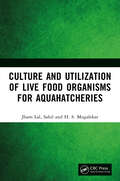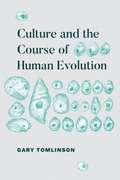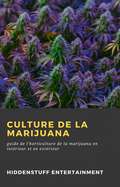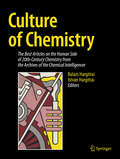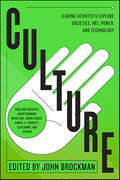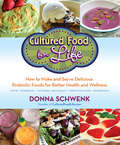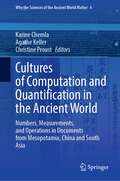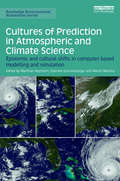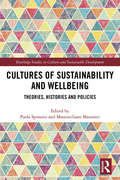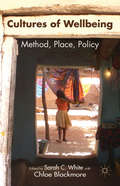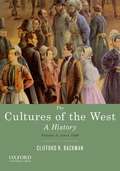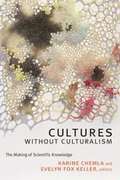- Table View
- List View
Culture and Human-Robot Interaction in Militarized Spaces: A War Story (Emerging Technologies, Ethics and International Affairs)
by Julie CarpenterExplosive Ordnance Disposal (EOD) personnel are some of the most highly trained people in the military, with a job description that spans defusing unexploded ordnance to protecting VIP’s and state dignitaries. EOD are also one of the first military groups to work with robots every day. These robots have become an increasingly important tool in EOD work, enabling people to work at safer distances in many dangerous situations. Based on exploratory research investigating interactions between EOD personnel and the robots they use, this study richly describes the nuances of these reciprocal influences, especially those related to operator emotion associated with the robots. In particular, this book examines the activities, processes and contexts that influence or constrain everyday EOD human-robot interactions, what human factors are shaping the (robotic) technology and how people and culture are being changed by using it. The findings from this research have implications for future personnel training, and the refinement of robot design considerations for many fields that rely on critical small group communication and decision-making skills.
Culture and Morality: The Relativity of Values in Anthropology
by Elvin HatchContents<P><P> 1. The Facets of Relativism <P> 2. The Historical Context <P> 3. The New Self-Identity <P> 4. The Call for Tolerance <P> 5. The Limits of Tolerance <P> 6. A Growing Disaffection <P> 7. A Working Alternative
Culture and Neural Frames of Cognition and Communication (On Thinking #3)
by Ernst Pöppel Shihui HanCultural neuroscience combines brain imaging techniques such as functional magnetic resonance imaging and event-related brain potentials with methods of social and cultural psychology to investigate whether and how cultures influence the neural mechanisms of perception, attention, emotion, social cognition, and other human cognitive processes. The findings of cultural neuroscience studies improve our understanding of the relation between human brain function and sociocultural contexts and help to reframe the "big question" of nature versus nurture. This book is organized so that two chapters provide general views of the relation between biological evolution, cultural evolution and recent cultural neuroscience studies, while other chapters focus on several aspects of human cognition that have been shown to be strongly influenced by sociocultural factors such as self-concept representation, language processes, emotion, time perception, and decision-making. The main goal of this work is to address how thinking actually takes place and how the underlying neural mechanisms are affected by culture and identity.
Culture and Psychology: How and Why Neuropsychological Modules Arise (Culture and Psychology)
by Ellis Mark Solms George F. R.The nature/nurture question is an age-old problem. Beyond Evolutionary Psychology deals with the relation between culture, evolution, psychology and emotion, based both in the underlying biology, determined by our evolutionary heritage, and in the interaction of our brain with the physical, ecological and social environment, based in the key property of brain plasticity. Ellis and Solms show how the brain structures that underlie cognition and behaviour relate to each other through developmental processes guided by primary emotional systems. This makes very clear which brain modules are innate or 'hard-wired', and which are 'soft-wired' or determined through environmental interactions. The key finding is that there can be no innate cognitive modules in the neocortex, as this is not possible on both developmental and genetic grounds; in particular there can be no innate language acquisition device. This is essential reading for students and scholars of evolutionary psychology and evolutionary biology.
Culture and Structure at a Military Charter School
by Brooke JohnsonTaking military charter schools as her subject, and drawing on years of research at one school in particular, Brooke Johnson explores the underpinings of a culture based on militarization and neoliberal educational reforms and probes its effects on individual identity and social interactions at the school.
Culture and Sustainability: Exploring Stability and Transformation with the Cultures Framework
by Janet StephensonThis Open access book brings a cultural lens, and a distinctive analytical framework, to the problem of transitioning to a sustainable, low-carbon future. The world faces a seemingly impossible hurdle – to radically alter long-established social, economic and technological systems in order to live within the biophysical limits of the globe, while ensuring a just and enduring transition. The overarching premise of this book is that this cannot be achieved without widespread cultural change. ‘We need a change in culture’ is often used rhetorically, but what does this really mean?Stephenson starts by exploring culture’s elusiveness, describing its divergent interpretations before identifying core features of culture that are common across most definitions. These characteristics form the core of the cultures framework, an extensively tested approach to studying the links between culture and sustainability outcomes. The framework makes culture an accessible concept which can be analytically applied to almost any sustainability problem. Using many examples from around the world, Stephenson illustrates how cultural stability, cultural flexibility and cultural transformation all have a part to play in the sustainability transition. She guides the reader in the use of the cultures framework for policy development and to underpin research undertaken by individuals or by multi-disciplinary teams.Clearly and engagingly written, Culture and Sustainability is essential reading for academics, students, policy makers and indeed anyone interested in a sustainable future.
Culture and Utilization of Live Food Organisms for Aquahatcheries
by Jham Lal Sahil H. S. MogalekarIn today's world, food scarcity and food security are significant global concerns, with 811 million people suffering from hunger and 3 billion individuals unable to afford healthy diets. This book discusses fisheries and aquaculture as crucial contributors to nutritional security and the need for sustainable practices to meet the growing demand. The subject matter of this book covers: Recycling of Waste Through Tubifex Culture and Used as Live Food in Aquahatcheries Culture Techniques of Daphnia Mosquito Larval Control Through the Larvivorous Fish Chlorella Live Food: Cultivation and Applications Print edition not for sale in South Asia (India, Sri Lanka, Nepal, Bangladesh, Pakistan and Bhutan)
Culture and the Course of Human Evolution
by Gary TomlinsonThe rapid evolutionary development of modern Homo sapiens over the past 200,000 years is a topic of fevered interest in numerous disciplines. How did humans, while undergoing few physical changes from their first arrival, so quickly develop the capacities to transform their world? Gary Tomlinson’s Culture and the Course of Human Evolution is aimed at both scientists and humanists, and it makes the case that neither side alone can answer the most important questions about our origins. Tomlinson offers a new model for understanding this period in our emergence, one based on analysis of advancing human cultures in an evolution that was simultaneously cultural and biological—a biocultural evolution. He places front and center the emergence of culture and the human capacities to create it, in a fashion that expands the conceptual framework of recent evolutionary theory. His wide-ranging vision encompasses arguments on the development of music, modern technology, and metaphysics. At the heart of these developments, he shows, are transformations in our species’ particular knack for signmaking. With its innovative synthesis of humanistic and scientific ideas, this book will be an essential text.
Culture de la Marijuana: guide de l'horticulture de la marijuana en intérieur et en extérieur
by Hiddenstuff EntertainmentLa référence ultime et le guide étape par étape de la culture et de la culture de la marijuana. Apprenez et cultivez du cannabis avec des étapes faciles à suivre du début à la fin. Comprenez et commencez à grandir en quelques heures. Instructions étape par étape simples et faciles à suivre. En utilisant les stratégies de croissance les plus efficaces, vous pouvez vous développer comme le font les pros. Voici ce qui est inclus -Conception de votre espace de culture -Éclairage -Aération -Comment suivre la croissance des plantes -Types d'environnement en croissance -Conteneurs -Nutriments -Arroser vos plantes Économisez du temps et de l'argent en utilisant ce guide ultime. - Faites défiler vers le haut de la page et cliquez sur Ajouter au panier pour acheter instantanément - Avertissement Cet auteur et / ou propriétaire (s) des droits ne fait aucune réclamation, promesse ou garantie quant à l'exactitude, l'exhaustivité ou l'adéquation du contenu de ce livre, et décline expressément toute responsabilité pour les erreurs et omissions dans le contenu qu'il contient. Ce produit est pour une utilisation de référence seulement.
Culture of Animal Cells
by R. Ian FreshneySince the publication of the sixth edition of this benchmark text, numerous advances in the field have been made - particularly in stem cells, 3D culture, scale-up, STR profiling, and culture of specialized cells. Culture of Animal Cells: A Manual of Basic Technique and Specialized Applications, Seventh Edition is the updated version of this benchmark text, addressing these recent developments in the field as well as the basic skills and protocols. This eagerly awaited edition reviews the increasing diversity of the applications of cell culture and the proliferation of specialized techniques, and provides an introduction to new subtopics in mini-reviews. New features also include a new chapter on cell line authentication with a review of the major issues and appropriate protocols including DNA profiling and barcoding, as well as some new specialized protocols. Because of the continuing expansion of cell culture, and to keep the bulk of the book to a reasonable size, some specialized protocols are presented as supplementary material online. Culture of Animal Cells: A Manual of Basic Technique and Specialized Applications, Seventh Edition provides the most accessible and comprehensive introduction available to the culture and experimental manipulation of animal cells. This text is an indispensable resource for those in or entering the field, including academic research scientists, clinical and biopharmaceutical researchers, undergraduate and graduate students, cell and molecular biology and genetics lab managers, trainees and technicians.
Culture of Chemistry: The Best Articles on the Human Side of 20th-Century Chemistry from the Archives of the Chemical Intelligencer
by Balazs Hargittai István HargittaiIncludes specially selected articles that previously appeared in The Chemical Intelligencer magazine published (1995-2000). Excerpts of these Editor's choice chapters chronicle the culture and history of chemistry, featuring great chemists and discoverers. Contributors from among the best-known authors of the chemistry community, including numerous Nobel laureates. Features behind the scenes stories about pivotal discoveries, intricacies of laboratory life and interactions among scientists, favorite recipes of renowned researchers, life histories and anecdotes. Chapters detail the human side of science but also present scientific information communicated in an easy-to-perceive and entertaining way. This unique book is not only aimed at chemists but individuals who are interested in the cultural aspects of our science.
Culture of The Sacred Space (Advances in Science, Technology & Innovation)
by Olimpia NiglioThis book highlights the relationship between sacred architecture and tourism, specifically focusing on the role of interior design strategies. It explores how the interior design of sacred spaces can influence the tourist experience and shape their perception of these places. The book touches upon elements such as spatial organization, symbolism, material selection, lighting, and acoustics, all of which contribute to creating a meaningful and immersive environment for visitors. It explores the architectural design, ideological motivations, and the historical context surrounding the palace's construction. The book also addresses the eventual abandonment of the project and its transformation of their uses, reflecting on the complexities of realizing utopian visions in architecture. It examines how the sanctuary's architectural design and spatial arrangement interact with the surrounding landscape, including elements such as topography, vegetation, and water features. Moreover, it focuses on the interior design and explores the symbolism, spatial organization, artistic elements, and spiritual experiences associated with the dome interiors of these structures. The book showcases the historical context, cultural influences, and the evolution of design principles that shaped these remarkable spaces. Also, this book investigates the transition of visionary architectural drawings from the realm of professional architects. Furthermore, it explores how architectural drawings serve as a medium for expressing imaginative and utopian ideas, and how this transition occurs in the context of architectural education.
Culture: Leading Scientists Explore Civilizations, Art, Networks, Reputation, and the Online Revolution (Best of Edge Series)
by John Brockman"Theway Brockman interlaces essays about research on the frontiers of science withones on artistic vision, education, psychology and economics is sure to buzzany brain." —Chicago Sun-Times, on This Will Change EverythingLaunchinga hard-hitting new series from Edge.org and Harper Perennial, editor JohnBrockman delivers this cutting-edge master class covering everything you needto know about Culture. With original contributions by the world’sleading thinkers and scientists, including Jared Diamond, Daniel C. Dennett,Brian Eno, Jaron Lanier,Nicholas Christakis, and others, Culture offers a mind-expanding primeron a fundamental topic. Unparalleled in scope, depth, insight and quality, Edge.org’s Culture is not to be missed.
Cultured Food for Health: A Guide To Healing Yourself With Probiotic Foods Kefir * Kombucha * Cultured Vegetables
by Donna SchwenkIf youre having digestive problems or feeling sick and rundownor if you simply want to feel better and have more energythis is the book for you. In Cultured Food for Health, Donna Schwenk opens your eyes to the amazing healing potential of cultured foods. Focusing on the notion that all disease begins in the guta claim made by Hippocrates, the father of medicine, more than 2000 years agoshe brings together cutting-edge research, firsthand accounts from her online community, and her personal healing story to highlight the links between an imbalanced microbiome and a host of ailments, including high blood pressure, allergies, depression, autism, IBS, and so many more.Then she puts the power in your hands, teaching you how to bring three potent probiotic foodskefir, kombucha, and cultured vegetablesinto your diet. Following the advice in these pages, along with her 21-day program, you can easily (and deliciously!) flood your system with billions of good bacteria, which will balance your body and allow it to heal naturally.In this book, youll find:*;Step-by-step instructions on how to make basic kefir, kombucha, and cultured vegetables*;More than 100 tasty, easy-to-make recipes, from smoothies to desserts, that feature probiotic foods*;A three-week program with day-by-day instructions on gathering supplies and ingredients, and making and eating cultured foods*;Helpful answers to some of the most frequently asked questions about culturing*;Hints and tips about how to easily incorporate cultured foods into your life*;Exciting information on the probiotic-enhancing properties of prebiotic foods, such as apples, broccoli, onions, squash, brussels sprouts, and honey
Cultured Food for Life: How To Make And Serve Delicious Probiotic Foods For Better Health And Wellness
by Donna SchwenkDonna Schwenk's world changed when she discovered cultured foods. After a difficult pregnancy and various health problems, she became determined to find answers to what ailed her. And in her quest, she came across the ancient art of home fermentation, a food preparation technique that supercharges everyday foods with beneficial bacteria to balance your digestive system, and vitamins and minerals to enhance your overall health. This simple, natural process has been used for thousands of years to create everything from drinks like kefir and kombucha to foods like kimchi and pickles. After incorporating fermented foods into her life, Donna began to experience a vitality that she had never known. And then she was hooked! She started a new life as a teacher and writer, blogging on her website culturedfoodlife.com, in an effort to bring the beautiful world of fermented foods to as many people as possible. She now works with thousands of people to open the door to a world of foods that can help improve an array of health problems including high blood pressure, diabetes, allergies, acne, hypertension, asthma, and irritable bowel syndrome. In Cultured Food for Life Donna brings this same information to you and shows you that preparing and eating cultured foods is easy, fun, and delicious! After speaking to the science behind the healing power of probiotic foods and telling the astonishing story of how she healed herself and her family, Schwenk walks you, step by step, through the basic preparation techniques for kefir, kombucha, cultured vegetables, and sprouted flour, plus more than 135 recipes that use these foods to create dishes to please any palate. With recipes like Herbed Omelet with Kefir Hollandaise Sauce,Sprouted Ginger Scones with Peaches and Kefir Cream,Kefir Veggie Sprouted Pizza, Apple Sauerkraut, and Brownie Cupcakes with Kefir Frosting, along with inspirational stories from Donna's family and friends, you'll learn everything you want to know about a diet that's as tasty as it is healthy.
Cultured: How Ancient Foods Can Feed Our Microbiome
by Katherine Harmon CourageA revealing look at the 300 trillion microorganisms that keep us healthy—and the foods they need to thrive These days, probiotic yogurt and other "gut-friendly" foods line supermarket shelves. But what's the best way to feed our all-important microbiome—and what is a microbiome, anyway? In this engaging and eye-opening book, science journalist Katherine Harmon Courage investigates these questions, presenting a deep dive into the ancient food traditions and the latest research for maintaining a healthy gut. Courage’s insights include: • Meet your microbiome: What it is, how it works, and why it's essential for our immune system--and overall health • Gut-friendly food traditions: A guided tour of artisanal makers of yogurt, kimchi, kefir, kombucha, olives, cocoa, and other vibrant, ancient foods from around the world that feed our microbiome (along with simple recipes for curious at-home cooks) • Cutting-edge science: A first-hand look at some of the top lab facilities where microbiologists are working to better understand the human gut and how to feed it for good health Equal parts science explainer, culinary investigation, and global roadmap for healthy eating, Cultured offers a wealth of information for anyone interested in making smart food choices in our not-so-gut-friendly modern world.
Cultures and Globalization: Conflicts and Tensions (The Cultures and Globalization Series)
by Helmut K. Anheier Yudhishthir Raj IsarThe world's cultures and their forms of creation, presentation, and preservation are deeply affected by globalization in ways that are inadequately documented and understood. The Cultures and Globalization Series is designed to fill this void in our knowledge.<P> Analyzing the relationship between globalization and cultures is the aim of the Series. In each volume, leading experts as well as young scholars will track cultural trends connected to globalization throughout the world, covering issues ranging from the role of cultural difference in politics and governance to the evolution of the cultural economy and the changing patterns of creativity and artistic expression. Each volume will also include an innovative presentation of newly developed 'indicator suites' on cultures and globalization that will be presented in a user-friendly form with a high graphics content to facilitate accessibility and understanding.<P> The inaugural theme is 'Conflicts and Tensions': the cultural dimensions of conflict and the conflictual dimensions of culture. Like so many phenomena linked to globalization, conflicts over and within the cultural realms crystallize great anxieties and illusions, through misplaced assumptions, inadequate concepts, unwarranted simplifications and instrumental readings. The aim here is to marshal evidence from different disciplines and perspectives about the culture, conflict and globalization relationships in conceptually sensitive ways. Thus, in a broad and genuine sense, the Cultures and Globalization Series means not only to promote better understanding of contemporary cultural change but also to serve the cause of peace and security through informed, open and diversified debate.
Cultures of Computation and Quantification in the Ancient World: Numbers, Measurements, and Operations in Documents from Mesopotamia, China and South Asia (Why the Sciences of the Ancient World Matter #6)
by Karine Chemla Agathe Keller Christine ProustThis book sheds light on the variety of mathematical cultures in general. To do so, it concentrates on cultures of computation and quantification in the ancient world, mainly in ancient China, South Asia, and the Ancient Near East and offers case studies focused on numbers, quantities, and operations, in particular in relation to mathematics as well as administrative and economic activities. The various chapters focus on the different ways and contexts of shaping numbers and quantities, and on the procedures applied to them. The book places special emphasis on the processes of emergence of place-value number systems, evidenced in the three geographical areas under study All these features yield essential elements that will enable historians of mathematics to further capture the diversity of computation practices in their contexts, whereas previous historical approaches have tended to emphasize elements that displayed uniformity within “civilizational” blocks. The book includes editions and translations of texts, some of them published here for the first time, maps, and conventions for editions of ancient texts. It thereby offers primary sources and methodological tools for teaching and learning. The volume is aimed at historians and philosophers of science and mathematics, historians of the ancient worlds, historians of economics, sinologists, indologists, assyriologists, as well as undergraduate, graduate students and teachers in mathematics, the history and philosophy of science and mathematics, and in the history of ancient worlds.
Cultures of Mass Tourism: Doing the Mediterranean in the Age of Banal Mobilities (New Directions in Tourism Analysis)
by Pau Obrador PonsWith more than 230 million international tourists a year, the Mediterranean region is the largest tourist destination in the world. This book outlines that its economic importance is matched by its significance as a cultural and aesthetic phenomenon. Through a series of ethnographic insights into some of the key sites of mass Mediterranean tourism, it focuses on package tourists' experiences of the serial, banal and depthless spaces that are mushrooming along the coast and the enchantments, dissolutions and dreams that saturate them. Moving away from the notion of authentic places corrupted by mass tourism, the book shows how new forms and spaces are made and remade by the mobilities and performances of locals, workers and tourists. Finally, the book looks at the complex materialities of mass tourism and the many networks that make it possible.
Cultures of Prediction in Atmospheric and Climate Science: Epistemic and Cultural Shifts in Computer-based Modelling and Simulation (Routledge Environmental Humanities)
by Matthias Heymann Gabriele Gramelsberger Martin MahonyIn recent decades, science has experienced a revolutionary shift. The development and extensive application of computer modelling and simulation has transformed the knowledge‐making practices of scientific fields as diverse as astro‐physics, genetics, robotics and demography. This epistemic transformation has brought with it a simultaneous heightening of political relevance and a renewal of international policy agendas, raising crucial questions about the nature and application of simulation knowledges throughout public policy. Through a diverse range of case studies, spanning over a century of theoretical and practical developments in the atmospheric and environmental sciences, this book argues that computer modelling and simulation have substantially changed scientific and cultural practices and shaped the emergence of novel ‘cultures of prediction’. Making an innovative, interdisciplinary contribution to understanding the impact of computer modelling on research practice, institutional configurations and broader cultures, this volume will be essential reading for anyone interested in the past, present and future of climate change and the environmental sciences.
Cultures of Prediction: How Engineering and Science Evolve with Mathematical Tools (Engineering Studies)
by Ann Johnson Johannes LenhardA probing examination of the dynamic history of predictive methods and values in science and engineering that helps us better understand today&’s cultures of prediction.The ability to make reliable predictions based on robust and replicable methods is a defining feature of the scientific endeavor, allowing engineers to determine whether a building will stand up or where a cannonball will strike. Cultures of Prediction, which bridges history and philosophy, uncovers the dynamic history of prediction in science and engineering over four centuries. Ann Johnson and Johannes Lenhard identify four different cultures, or modes, of prediction in the history of science and engineering: rational, empirical, iterative-numerical, and exploratory-iterative. They show how all four develop together and interact with one another while emphasizing that mathematization is not a single unitary process but one that has taken many forms.The story is not one of the triumph of abstract mathematics or technology but of how different modes of prediction, complementary concepts of mathematization, and technology coevolved, building what the authors call &“cultures of prediction.&” The first part of the book examines prediction from early modernity up to the computer age. The second part probes computer-related cultures of prediction, which focus on making things and testing their performance, often in computer simulations. This new orientation challenges basic tenets of the philosophy of science, in which scientific theories and models are predominantly seen as explanatory rather than predictive. It also influences the types of research projects that scientists and engineers undertake, as well as which ones receive support from funding agencies.
Cultures of Sustainability and Wellbeing: Theories, Histories and Policies (Routledge Studies in Culture and Sustainable Development)
by Massimiliano Mazzanti Paola SpinozziCultures of Sustainability and Wellbeing: Theories, Histories and Policies examines and assesses the interdependence between sustainability and wellbeing by drawing attention to humans as producers and consumers in a post-human age. Why wellbeing ought to be regarded as essential to sustainable development is explored first from multifocal theoretical perspectives encompassing sociology, literary criticism and socioeconomics, second in relation to institutions and policies, and third with a focus on specific case studies across the world. Wellbeing and its sustainability are defined in terms of biological and cultural diversity; stages of advancement in science and technology; notions of citizenship and agency; geopolitical scenarios and environmental conditions. Wellbeing and sustainability call for enquiries into human capacities in ontological, epistemological and practical terms. A view of sustainability that revolves around material and immaterial wellbeing is based on the assumption that life quality, comfort, happiness, security, safety always posit humans as both recipients and agents. Risk and resilience in contemporary societies define the intrinsically human ability to make and consume, to act and adapt, driving the search for and fruition of wellbeing. How to sustain the dual process of exploitation and regeneration is a task that requires integrated approaches from the sciences and the humanities, jointly tracing a worldwide cartography with clear localisations. This book will be of great interest to students and researchers interested in sustainability through conceptual and empirical approaches including social theory, literary and cultural studies, environmental economics and human ecology, urbanism and cultural geography.
Cultures of Wellbeing: Method, Place, Policy
by Sarah C. White Chloe BlackmoreThe authors challenge psychological perspectives on happiness and subjective wellbeing. Highlighting the politics of quantitative and qualitative methodologies, case studies across continents explore wellbeing in relation to health, children and youth, migration, economics, religion, family, land mines, national surveys, and indigenous identities.
Cultures of the West: Since 1350
by Clifford R. BackmanThe book highlights on the ways in which the major ideas like religion, science, and philosophy and passions of Western culture developed, internally, and how they interacted with the rest of the world.
Cultures without Culturalism: The Making of Scientific Knowledge
by Evelyn Fox Keller Karine ChemlaCultural accounts of scientific ideas and practices have increasingly come to be welcomed as a corrective to previous—and still widely held—theories of scientific knowledge and practices as universal. The editors caution, however, against the temptation to overgeneralize the work of culture, and to lapse into a kind of essentialism that flattens the range and variety of scientific work. The book refers to this tendency as culturalism. The contributors to the volume model a new path where historicized and cultural accounts of scientific practice retain their specificity and complexity without falling into the traps of culturalism. They examine, among other issues, the potential of using notions of culture to study behavior in financial markets; the ideology, organization, and practice of earthquake monitoring and prediction during China's Cultural Revolution; the history of quadratic equations in China; and how studying the "glass ceiling" and employment discrimination became accepted in the social sciences. Demonstrating the need to understand the work of culture as a fluid and dynamic process that directly both shapes and is shaped by scientific practice, Cultures without Culturalism makes an important intervention in science studies. Contributors. Bruno Belhoste, Karine Chemla, Caroline Ehrhardt, Fa-ti Fan, Evelyn Fox Keller, Kenji Ito, Guillaume Lachenal, Donald MacKenzie, Mary Morgan, Nancy Nersessian, David Rabouin, Hans-Jörg Rheinberger, Claude Rosental, Koen Vermeir


